| Newsletter
- of the CIETA Embroidery Group Bulletin d’Information de Groupe Broderie de CIETA No 4 |
 |
| Dear members, | St Gallen, 6th January 1997 |
ANNE WANNER'S Textiles in History / CIETA Embroidery Newsletters
|
| To all of you I am
wishing that this very new year will be a healthy, a
happy, a successful and a good one. Thank you for your
cards and letters. It is also good to hear, that there is
correspondance between the members. In October I travelled to St Petersburg again to participate in a conference in the Hermitage Museum. Here I met the curator of the embroidery department, Dr. Tatiana Kosourova. She showed me a sampler collection, whitework embroideries of the 18th c., and other very interesting pieces of european embroidery. Tatiana Volchkova is in charge of lace and fabrics. Head of the textile department is Dr. Nina Biriukova and she is a specialist of tapestry. An interesting special exhibition in the Hermitage Museum informs about its textile collection. The catalogue is informative and has many coloured plates. If you feel better to write to me in french or also in italian, please do not hesitate to do so. I understand french but my written french will probably be somewhat hazardous! Awaiting your news, I am sending to all of you my best wishes yours Anne Wanner-JeanRichard |
General
Information: |
| General Information: You will find a new list of members
in this letter with some Fax Nrs. Assenblee Generale du
Centre Francais d’Histoire de la Broderie: Meeting in September 1997 and specialist groups: So far there seems to be an interest in the discussion of church embroideries of 17th and 18th c. Could you possibly bring to the conference photographs of important or special vestments of your collection? Which facts are known and what are the questions ? Ten International Felt
and Embroidery artists will be giving workshops during
the period of Art of the stitch: 17.6.-27.7.1997
open to everybody |
| As there are
no more general informations, I am adding here the
information about 2 new exhibits in the Textilmuseum St
Gallen. I will publish here your Museum News too if you
send the information: - Nov 6th 1996 to October 1997: Cashmere shawls (there are some embroidered pieces as well) - March 20th 1997 to February 28th 1998: Embroideries from Zagreb to Istanbul |
|
embroidery
technique: drawn-thread work |
| Marianne
Ellis Ashmolean Museum, Oxford, Department of Eastern Art embroidery, Mamluk Egypt, 13/14c contribution by Marianne Ellis: This roundel is from the Newberry collection of Islamic embroideries. It came either from an excavation or from rubbish dumps and was acquired by Professor P.Newberry, the Egyptologist, in the 1920s or 1930s. The scrolling leaf design appears on tapestry woven fabrics from the Coptic period but here it has been embroidered in the technique known as "laid and couched by a couched line". Some other fragments in the collection worked in this way, also in red silk, have designs that suggest they are from the late 13, early 14c. Originally the roundel would been highly decorative in appearance with its central openwork in yellow and blue silk embroidery surrounded by a red silk scrolling border. The drawn-thread work in the centre of this roundel is the only one worked precisely this way in the collection (see diagram) although there are other examples of drawn-thread work. If anyone has similar roundels or comments to make about the classification of openwork techniques, please contact me c/o Department of Eastern Art. |
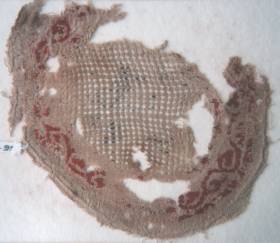
|
embroidery
technique: drawn-thread work |
| Marianne
Ellis Ashmolean Museum, Oxford, Department of Eastern Art embroidery, Mamluk Egypt, 13/14c |
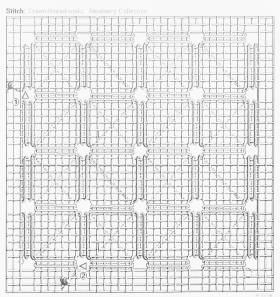 |
Samplers
of Dresdenwork: pulled threadwork |
| Ruth
Bleckwenn, Muenster Professor at Westfael. Wilhelms-Universitaet samplers of Kunstgewerbemuseum in Dresden, in pulled threadwork Prof Bleckwenn is studying the Dresdenwork embroideries and she sent the following examples. Some differences are very obvious, but there are no clear results so far. Ruth Bleckwenn hopes that more research will give a more definite datation of the pieces. |
Inv.No 14982, 28cm x 28 cm, netlike surface decoration |
Inv.No 364, 17cm x 26cm, pattern more dense |
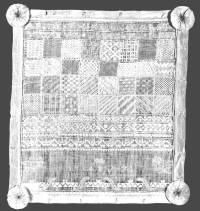 Inv.No 365, 24cm x 2cm, date 1771, alphabet and date in cross stitch |
Inv.No 366. 22.5cm x 22.5cm, date 1767 ? |
embroidery
technique: pulled threadwork |
| Textilmuseum
St Gallen and Museum Appenzell by Anne Wanner Samplers eastern part of Switzerland, 2nd half of 19th cent. In the
Textilmuseum St Gallen there are a number of embroidered
table cloths similar to the London example, published in
Newsletter No 3. The earliest of these table cloths of
the Textilmuseum can have been worked in the end of 19th
cent., others are much later, probably up to the
1930’s. The earlier ones are worked with very fine
material and some of them copy exactly well known prints
of the time, like for instance illustrations of Faust by
Goethe. The Museum of Appenzell (eastern Switzerland) shows in its exhibition some samplers with pulled threadwork. They can be dated to the second half of 19th cent., as the dates of life of some of the embroiderers are known. |
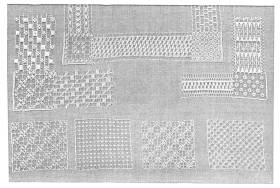 Detail of Sampler, end of 19th cent, Swiss, Appenzell , Textilmuseum St Gallen, TM 20213, pulled threadwork, Cat.Nr. 214, 15 x 11cm
Detail of sampler, Swiss, Appenzell, 2nd half of 19th cent., made by Mrs M.Antonia Faessler-Doerig (1827-1908), Museum of Appenzell, pulled threadwork, 10 x 7cm |
Narodni
Muzej, Ljublijana |
| Narodni
Muzej, Presernvoa 20 1000 Ljublijana, Fax: 00386 61 221 882 Mrs Gojka Pajagic-Bregar reported by AW |
chasuable around 1700, Ljubliana chasuable around 1700, Ljubliana |
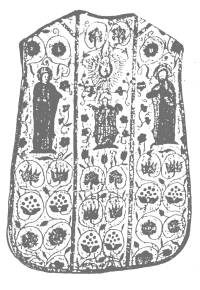 |
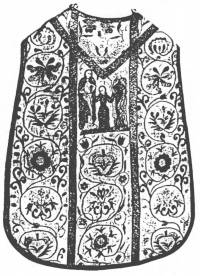 |
Textilmuseum
St.Gallen, Switzerland |
| Textilmuseum
St Gallen and Raetisches Museum Chur by Anne Wanner Ecclesiastical filofloss embroidery The Textile museum St
Gallen has in its collection an Altarfrontal worked in
the same technique as the vestments of Ljubljana. Similar
embroideries can be found in Raetisches Museum at Chur
and also in some churches of the Swiss Cantons of Grisons
and St Gallen. |
chasuable around 1700, Canton of Grisons detail from
Altar frontal, Switzerland 17th c. |
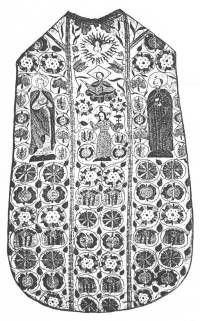 |
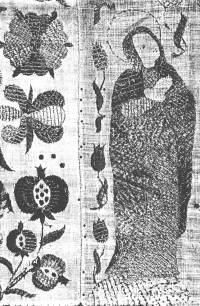 |
question:
wool work design |
| Margaret
Swain, Edinburgh examples of Berlin Wool-work embroideries This collection of pictures in
cross-stitch on canvas was worked around 1838-40. Some of
the designs were bought in Belgium. |
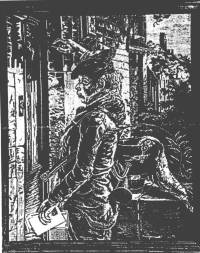 |
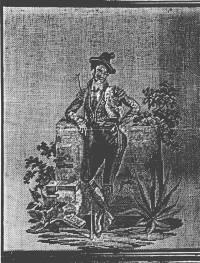 |
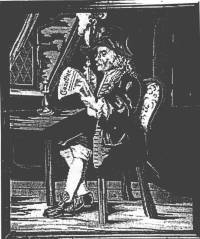 |
Musee
Historique des Tissus, Lyon |
| Guy
Blazy, Conservateur informs
about a new acquisition Allegorie de la Monarchie, signee et datee: Jenny Larue, Lyon, 1816 Broderie peinture à L’aiguille et peinture sur satin de soie H. 1,04m; L. 0,77m Dediee à la duchesse d’Angoulême, cette broderie a ete realisee à Lyon par Jenny Larue en mai 1816, d’apres une estampe marquee du 3 mai 1814 dont l’idee fut donnee en 1799 par un prelat de l’eglise gallicane refugie en Espagne. Elle prône le retablissement de la religion et de la monarchie apres les desastres de la Revolution française. Au registre inferieur, agenouilles de part et d’autre de la Foi, Louis XVIII et Pie VI devant la barque de l’Eglise et de Saint-Pierre de Rome; au registre central, la Vierge, les saintes reines de France et les fondatrices de la Visitation et des Carmelites, saint Louis et Charlemagne; au registre superieur, les sept piliers de la Sagesse et la Sainte-Trinite. Un excepionnel cadre en bois dore et stuque participe au programme, aux armes des rois de France et de la ville de Lyon. |
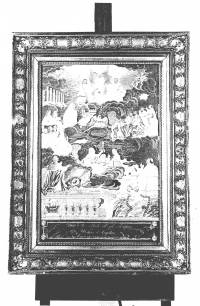 |
book review: Embroidery in
Britain |
| title:
Embroidery in Britain from 1200 - 1750 authors: Donald King, Santina Levey year: 1993, 1995 pages: 112 illustrations: 123 coloured plates |
Exhibition Hermitage |
| title: West
European applied Arts in the 16th - 18th century, from
the Hermitage Collection author: N. Biriukova (tapestry), T. Volchkova (fabrics), T. Kosourova (embroidery) and others text in Russian and English year: St. Petersburg 1996 pages: 142 illustrations: coloured plates in great number ISBN: 5-88654-033-4 |
decorative
Art in the 19th century |
| From october
21st to 24th there was a conference in the State
Hermitage Museum, St Petersburg on Decorative Art in the 19th century. Anne Wanner attended the conference
in St Petersburg, here my report: - mages of Ancient Egypt
in the Architecture of St.Petersburg - There followed reports
on some special objects of the 19th century: - Then there were some
reports on textiles: |
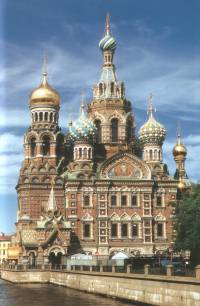 Church of the Resurrection of Christ, in memoriam of the assassination of Zar Alexander II in 1881 |
| There was a
concert in the theatre of Catherine the Great, a guided
tour of the newly restaured Church of the Resurrection of
Christ (built 1883-1907) and an excursion to the so
called "Cottage Palace" in Neo-gothic style in
Peterhof. About 50 historians, mostly ladies, attended the conference. They came from different parts of Russia. Sometimes historian and students from the Hermitage staff joined the conference. Additionally there was a german lady from Hildesheim and and another foreign lady from Switzerland (myself!!). A Russian - English translator helped with language problems. |
| home newsletters | Last revised August 12, 2000 |